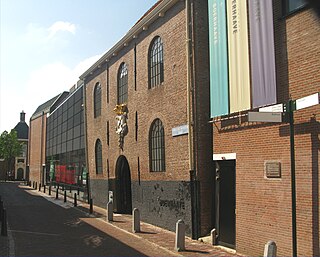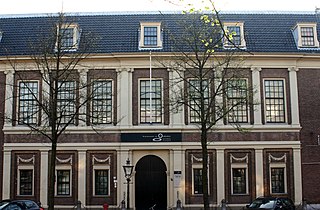The National Museum of Natural History is in Washington, D.C., United States.
National Museum of Natural History may also refer to:

Leiden is a city and municipality in the province of South Holland, Netherlands. The municipality of Leiden has a population of 127,046, but the city forms one densely connected agglomeration with its suburbs Oegstgeest, Leiderdorp, Voorschoten and Zoeterwoude with 215,602 inhabitants. The Netherlands Central Bureau of Statistics (CBS) further includes Katwijk in the agglomeration which makes the total population of the Leiden urban agglomeration 282,207 and in the larger Leiden urban area also Teylingen, Noordwijk, and Noordwijkerhout are included with in total 365,913 inhabitants. Leiden is located on the Oude Rijn, at a distance of some 20 km (12 mi) from The Hague to its south and some 40 km (25 mi) from Amsterdam to its north. The recreational area of the Kaag Lakes (Kagerplassen) lies just to the northeast of Leiden.

Entomology is the scientific study of insects, a branch of zoology. In the past the term insect was less specific, and historically the definition of entomology would also include the study of animals in other arthropod groups, such as arachnids, myriapods, and crustaceans. This wider meaning may still be encountered in informal use.

Leiden University is a public research university in Leiden, Netherlands. It was founded as a Protestant university in 1575 by William, Prince of Orange, making it the oldest institution of higher education in the Netherlands.

Hermann Schlegel was a German ornithologist, herpetologist and ichthyologist.

Leiden University Libraries is a library founded in 1575 in Leiden, Netherlands. It is regarded as a significant place in the development of European culture: it is a part of a small number of cultural centres that gave direction to the development and spread of knowledge during the Enlightenment. This was due particularly to the simultaneous presence of a unique collection of exceptional sources and scholars. Holdings include approximately 5,200,000 volumes, 1,000,000 e-books, 70,000 e-journals, 2,000 current paper journals, 60,000 Oriental and Western manuscripts, 500,000 letters, 100,000 maps, 100,000 prints, 12,000 drawings and 300,000 photographs. The library manages the largest collections worldwide on Indonesia and the Caribbean. Furthermore, Leiden University Libraries is the only heritage organization in The Netherlands with five registrations of documents in UNESCO's Memory of the World Register.

Rijksmuseum Boerhaave is a museum of the history of science and medicine, based in Leiden, Netherlands. The museum hosts a collection of historical scientific instruments from all disciplines, but mainly from medicine, physics, and astronomy.

Naturalis Biodiversity Center is a national museum of natural history and a research center on biodiversity in Leiden, Netherlands. It was named the European Museum of the Year 2021. Although its current name and organization are relatively recent, the history of Naturalis can be traced back to the early 1800s. Its collection includes approximately 42 million specimens, making it one of the largest natural history collections in the world.

The Rijksmuseum van Oudheden is the national archaeological museum of the Netherlands, located in Leiden. It grew out of the collection of Leiden University and still closely co-operates with its Faculty of Archaeology. The museum calls itself "the national centre for archaeology" and focuses on ancient Egypt, the ancient Near East, the classical world of Greece, Etruria and Rome and the early Netherlands.

Professor David John Mabberley, is a British-born botanist, educator and writer. Among his varied scientific interests is the taxonomy of tropical plants, especially trees of the families Labiatae, Meliaceae and Rutaceae. He is perhaps best known for his plant dictionary The plant-book. A portable dictionary of the vascular plants. The third edition was published in 2008 as Mabberley's Plant-book, for which he was awarded the Engler Medal in Silver in 2009. As of June 2017 Mabberley's Plant-book is in its fourth edition.

The National Museum of Natural History is a natural history museum in Luxembourg City, in southern Luxembourg. The museum is located in the Grund quarter on the eastern bank of the Alzette river, next to the Neumünster Abbey cultural centre.

The National Museum of History and Art, abbreviated to MNHA, is a museum located in Luxembourg City, in southern Luxembourg. It is dedicated to displaying artworks and artefacts from all epochs of Luxembourg history. The museum is situated in Fishmarket, the historic heart of the city, in the Ville Haute quarter.

The National Herbarium of the Netherlands is one of largest herbaria in the world with some 5.5 million specimens. It was established in 1999 through a decentralized merger of the major university herbaria of Leiden, Utrecht and Wageningen. Each of the three had its own focus.

Krijn is the common name of a Neanderthal fossil discovered off the Dutch coast. The discovery is most notable for being the first evidence of a Neanderthal presence in the Netherlands. The fossil is estimated at 100,000-40,000 BP. The skull fragment was recovered from the North Sea in 2001 off the coast of Zeeuws Vlaanderen. It was first publicly described in 2009.

Petrus Johannes Blok was a Dutch historian.
The following is a timeline of the history of Luxembourg City, Luxembourg.
The International Council of Museums defines a museum as "a not-for-profit, permanent institution in the service of society that researches, collects, conserves, interprets and exhibits tangible and intangible heritage. Open to the public, accessible and inclusive, museums foster diversity and sustainability. They operate and communicate ethically, professionally and with the participation of communities, offering varied experiences for education, enjoyment, reflection and knowledge sharing.”
The following is a timeline of the history of the municipality of Leiden, Netherlands.

Pieter Baas is a Dutch botanist and an emeritus professor of plant systematics at the Leiden University, who served as director of the Rijksherbarium of Leiden University between 1991 and 1999. When the institute was faced with budget cuts in 1993 he managed to preserve the collection by joining it with the university collections of Wageningen and Utrecht. This led to the founding of the National Herbarium of the Netherlands in 1999. Baas subsequently became director of the institute and served until 2005. As a botanist, Baas specializes in wood anatomy, and is an elected fellow of the International Academy of Wood Science.
Isaäk Martinus van der Vlerk was a Dutch paleontologist and geologist who worked in Dutch Indonesia where he was involved in stratigraphic studies based on foraminifera. He applied morphometric studies, examining curvature in foraminifera as a criterion, for determining geological ages of strata.